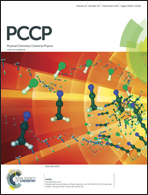Dynamic pattern formation of liquid crystals using binary self-assembled monolayers on an ITO surface under DC voltage†
Abstract
There have been numerous studies of liquid crystal (LC) convection using sandwich-type LC cells under AC voltage. In contrast to previous LC convection studies under AC voltage, we propose the use of a binary self-assembled monolayer (SAM) with a redox-active Ru complex and insulating octadecyl phosphonic acid (C18) molecules on an indium tin oxide (ITO) surface as the electrode of sandwich-type LC cells under DC bias voltage. This is because the functionalized molecules immobilized on the ITO surface are expected to control the LC orientation and electrical conduction of LC cells, under an exact DC bias voltage. We successfully achieved LC pattern formation using ITO electrodes with binary SAMs in LC cells. Moreover, we confirmed that the LC pattern size was increased by increasing the coverage of the Ru complex in binary SAMs. We consider that a combination of three factors, electrical conduction change, controlling of LC orientation in the initial stage and redox-activity of the Ru-complex, is the reason for LC convection although we cannot fully explain the distribution of these three factors. We believe that our LC pattern formation is promising for new type devices e.g., artificial compound eyes using the LC device technology.


 Please wait while we load your content...
Please wait while we load your content...